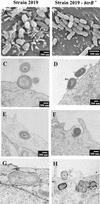Acylation of the lipooligosaccharide of Haemophilus influenzae and colonization: an htrB mutation diminishes the colonization of human airway epithelial cells
- PMID: 12117980
- PMCID: PMC128210
- DOI: 10.1128/IAI.70.8.4661-4668.2002
Acylation of the lipooligosaccharide of Haemophilus influenzae and colonization: an htrB mutation diminishes the colonization of human airway epithelial cells
Abstract
Haemophilus influenzae is a commensal and opportunistic pathogen of the human airways. A number of surface molecules contribute to colonization of the airways by H. influenzae, such as adhesins, including structures found in the lipooligosaccharide (LOS). A human bronchiolar xenograft model was employed to investigate the host-bacterial interactions involved in the colonization of the airway by H. influenzae. Differential display was used to identify H. influenzae mRNA that reflect genes which were preferentially expressed in the xenograft compared to growth. Eleven mRNA fragments had consistent increased expression when the bacteria grew in xenografts. On sequencing these fragments, eight open reading frames were identified. Three of these had no match in the NCBI or the TIGR database, while an additional three were homologous to genes involved in heme or iron acquisition and utilization: two of the mRNAs encoded proteins homologous to enzymes involved in LOS biosynthesis: a heptosyl transferase (rfaF) involved in the synthesis of the LOS core and a ketodeoxyoctonate phosphate-dependent acyltransferase (htrB) that performs one of the late acylation reactions in lipid A synthesis. Inoculation of human bronchiolar xenografts revealed a significant reduction in colonization capacity by htrB mutants. In vitro, htrB mutants elicited lesser degrees of cytoskeletal rearrangement and less stimulation of host cell signaling with 16HBE14o(-) cells and decreased intracellular survival. These results implicate acylation of H. influenzae lipid A as playing a key role in the organisms' colonization of the normal airway.
Figures




Similar articles
-
Susceptibility of nontypeable Haemophilus influenzae to human beta-defensins is influenced by lipooligosaccharide acylation.Infect Immun. 2002 Sep;70(9):5287-9. doi: 10.1128/IAI.70.9.5287-5289.2002. Infect Immun. 2002. PMID: 12183584 Free PMC article.
-
Mutation of the htrB locus of Haemophilus influenzae nontypable strain 2019 is associated with modifications of lipid A and phosphorylation of the lipo-oligosaccharide.J Biol Chem. 1995 Nov 10;270(45):27151-9. J Biol Chem. 1995. PMID: 7592970
-
Identification of the ADP-L-glycero-D-manno-heptose-6-epimerase (rfaD) and heptosyltransferase II (rfaF) biosynthesis genes from nontypeable Haemophilus influenzae 2019.Infect Immun. 1997 Apr;65(4):1377-86. doi: 10.1128/iai.65.4.1377-1386.1997. Infect Immun. 1997. PMID: 9119477 Free PMC article.
-
Molecular determinants of the interaction between Haemophilus influenzae and human cells.Am J Respir Crit Care Med. 1996 Oct;154(4 Pt 2):S192-6. doi: 10.1164/ajrccm/154.4_Pt_2.S192. Am J Respir Crit Care Med. 1996. PMID: 8876541 Review.
-
Non-typeable Haemophilus influenzae chronic colonization in chronic obstructive pulmonary disease (COPD).Crit Rev Microbiol. 2021 Mar;47(2):192-205. doi: 10.1080/1040841X.2020.1863330. Epub 2021 Jan 18. Crit Rev Microbiol. 2021. PMID: 33455514 Review.
Cited by
-
Site-specific activity of the acyltransferases HtrB1 and HtrB2 in Pseudomonas aeruginosa lipid A biosynthesis.Pathog Dis. 2015 Nov;73(8):ftv053. doi: 10.1093/femspd/ftv053. Epub 2015 Jul 29. Pathog Dis. 2015. PMID: 26223882 Free PMC article.
-
Identification of two late acyltransferase genes responsible for lipid A biosynthesis in Moraxella catarrhalis.FEBS J. 2008 Oct;275(20):5201-14. doi: 10.1111/j.1742-4658.2008.06651.x. Epub 2008 Sep 13. FEBS J. 2008. PMID: 18795947 Free PMC article.
-
Differential involvement of toll-like receptors 2 and 4 in the host response to acute respiratory infections with wild-type and mutant Haemophilus influenzae strains.Infect Immun. 2005 Apr;73(4):2075-82. doi: 10.1128/IAI.73.4.2075-2082.2005. Infect Immun. 2005. PMID: 15784548 Free PMC article.
-
Diminished ICAM-1 expression and impaired pulmonary clearance of nontypeable Haemophilus influenzae in a mouse model of chronic obstructive pulmonary disease/emphysema.Infect Immun. 2008 Nov;76(11):4959-67. doi: 10.1128/IAI.00664-08. Epub 2008 Sep 15. Infect Immun. 2008. PMID: 18794286 Free PMC article.
-
An outer membrane determinant for RNA phage genome entry in Pseudomonas aeruginosa.iScience. 2023 Dec 7;27(1):108675. doi: 10.1016/j.isci.2023.108675. eCollection 2024 Jan 19. iScience. 2023. PMID: 38213628 Free PMC article.
References
-
- Adhikari, P., S. D. Kirby, A. J. Nowalk, K. L. Veraldi, A. B. Schryvers, and T. A. Mietzner. 1995. Biochemical characterization of a Haemophilus influenzae periplasmic iron transport operon. J. Biol. Chem. 270:25142-25149. - PubMed
-
- Barcak, C. J., M. S. Chandler, R. J. Redfield, and J. F. Tomb. 1991. Genetic systems in Haemophilus influenzae. Methods Enzymol. 204:321-342. - PubMed
-
- Blank, M. L., T. Lee, V. Fitzgerald, and F. Snyder. 1981. A specific acetylhydrolase for 1-alkyl-2-acetyl-sn-glycero-3-phosphocholine (a hypotensive and platelet-activating lipid). J. Biol. Chem. 256:175-178. - PubMed
Publication types
MeSH terms
Substances
Grants and funding
LinkOut - more resources
Full Text Sources
Other Literature Sources

